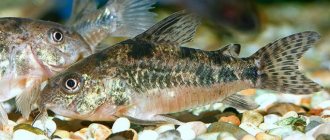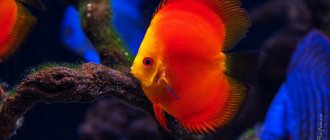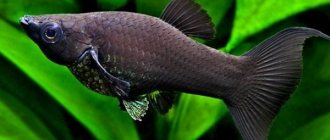Most aquarium fish lovers, of course, would like to see the maximum variety of aquatic flora and fauna in their home fish reserves.
In this regard, the Ancistrus catfish is able to introduce a special exoticism of the prehistoric underwater world into the aquarium environment familiar to many, due to the similarity of its appearance with some of its most ancient inhabitants.
Aquarium catfish Ancistrus
Ancistrus, with its appearance, stands out significantly from the general background of most aquarium fish. Its body, covered with a shell of bone plates, has an elongated, flattened shape. The lips, in the form of characteristic suction cups, form a rounded mouth located under the head. It is these suckers, formed as a result of millions of years of evolution, that allow Ancistrus to live in rivers with fast currents, holding onto any natural obstacles. And the same prehistoric shell helps these chain-mailed catfish resist predators. In addition, Ancistrus almost always stays near the bottom of the reservoir.
The colors of Ancistrus are not particularly diverse and depend on the specific species (see below). Basically, these catfish have gray, black, brown, pale yellow and reddish colors, of varying saturation and combination options.
The length of aquarium species of Ancistrus rarely reaches 15-16 centimeters, while their closest wild relatives, Pterygoplichthys, can grow up to 40 centimeters in length in natural conditions. Aquarium catfish live on average about 6-8 years, the maximum age of Pterygoplichts is 10 years.
Various species of Ancistrus have settled in almost all fast-flowing rivers of tropical and subtropical countries of the world. But populations of most Ancistrus species are most numerous in the Amazon River basin, which flows through several countries in South America.
As a zoological species, Ancistrus was first classified in the mid-19th century by the Austrian ichthyologist Rudolf Kner.
Table of basic parameters of maintenance, care and nutrition:
| What should be the volume of the aquarium? | from 50-100 liters |
| What should the temperature be? | from +20-26°C |
| What pH should be in the aquarium? | from 6-7.5 pH |
| What should the water hardness be? | up to 20°dH |
| What should the substrate be? | no sharp corners |
| What kind of lighting should there be? | moderate |
| What should be the movement of water | moderate |
| Maximum fish size | up to 16 cm (depending on type) |
| What does it eat? | tablets or granules, bloodworms, vegetables |
| Type of aquarium fish | not aggressive |
| Who is compatible with in an aquarium? | get along with small non-aggressive fish species |
general information
It is quite easy to distinguish Ancistrus from other species of catfish, since its mouth looks like a powerful suction cup . The fish is dark in color and has warty growths in front of it. All this makes her not entirely attractive, but this is what makes her stand out among others.
Thanks to the horn-shaped suckers, the catfish holds well on the walls of the aquarium, and it can also easily cling to snags, stones or leaves. Almost all day long, the sticky fish searches for food and thereby prevents algae from forming and purifies the water. Its homeland is South America.
Ancistrus is best kept in spacious aquariums, as it is quite active, but it also does well in small volumes. The main thing is that he has enough food and enough space to hide. it is advisable to put driftwood, coconuts or ceramic pots in the aquarium where such catfish live . You also need to take care of good water filtration, since these fish excrete a lot of waste products.
The color of these fish is different
Stickies, even in large aquariums, remain relatively small, their maximum length is approximately 15 cm. At the same time, the male ancistrus is always larger than the female, and he also has bushy spines on his head. In females, such growths are almost invisible or completely absent.
The colors of these fish vary. They are usually gray-yellow or black in color, and also have light spots on their bodies. Much less common are catfish that are black with white dots. Depending on the conditions in which they live, the color may become brighter or, conversely, paler.
The most common types of ancistrus catfish are the following:
- red;
- diamond;
- veil;
- star-shaped;
- gold;
- black.
All these fish differ from each other in color, but in appearance they are approximately the same. The lifespan of catfish is approximately six to eight years.
In this video you will learn more about this fish:
Catfish Ancistrus maintenance and care
Ancistrus will feel great in aquarium water with a temperature of 20-26 degrees, but 22 degrees is considered optimal for it. Water hardness should be in the range of up to 20°dH, acidity in the range of 6-7.5 pH.
Unlike most aquarium fish and other types of catfish, which require weekly renewal of about a third of the total water volume, for this catfish it is enough to change no more than a quarter of the aquarium water. Requirements for the degree of aeration and filtration of water are traditional.
For Ancistrus, it is important to provide a natural or simulated light cycle between day and night, including dawn and sunset. This is important to remember if additional lighting is used for the aquarium.
Ancistrus also requires the creation of elements of a natural habitat in the aquarium - a variety of plants, driftwood and large stones.
The selection of an aquarium of sufficient volume for these catfish depends on their number and type (see below), and is calculated based on 50-100 liters per pair of individuals (male and female).
conclusions
Ancistrus vulgaris is rightfully considered the most resilient fish, if not the most tenacious of all. They are great for adding to a home aquarium and these aquarium cleaners will live and constantly work on your aquarium. Of course, they have a camouflage shape and not a bright color, but the catfish is a very unusual fish that can be found hanging upside down in any part of the aquarium!
Previous
FishHow to feed your aquarium fish correctly?
Next
Fish Why lalius fish can be in the aquarium of any beginner
What and how to feed Ancistrus in a community aquarium
It is recommended to feed Ancistrus at night (or to simulate the onset of night); these catfish most often refuse to eat during daylight hours.
As a rule, they are fed tablets or granules, live food specially designed to feed most species of non-predatory aquarium catfish. Although, with a lack of plant food, there are known cases of some Ancistrus eating small fish. In this case, they will not refuse bloodworms.
Periodic feeding of catfish with natural plant food is also necessary. Fresh spinach and lettuce leaves, zucchini and cucumbers, as well as carrots are quite suitable for this, but before feeding, the vegetables need to be poured with boiling water for 5-10 minutes. True, if there is enough vegetation in the aquarium, overgrown with algae, additional feeding may not be necessary. By granting them this right, the owner of the aquarium will receive additional environmental cleaning of his home pond.
It should be remembered that this type of catfish has a very good appetite, so for each individual type of catfish you need to develop your own optimal diet, sufficient and not excessive.
Range and habitat
The natural habitat of ancistrus is fast-water rivers and streams of South, North and Central America. There are species living in mountain streams, swamps and ditches, and tropical forest lakes. Some of them lack a swim bladder, and the oral sucker is more developed than usual, which allows them to stay on the stone even during active currents.
The lamellar shell protects the catfish’s body from damage that can easily be sustained in a fast-water mountain stream.
Reproduction or breeding in a community aquarium
Most Ancistrus species are capable of spawning once every six years, that is, almost once in a lifetime. Therefore, the best option for their reproduction is to place fish ready for spawning in a separate aquarium, where they can create special conditions for the most efficient production of offspring.
These catfish can reproduce without any problems in a common aquarium, although with the inevitable loss of some of the eggs and fry, which will be eaten by other inhabitants of the common house. But an obstacle to this will be the formidable “armored” male, who becomes quite aggressive during the spawning period. After all, it is the male, and not the female, who is responsible for caring for the future offspring, as well as protecting the fertilized eggs and fry. After laying eggs, the female generally needs to be placed in a separate container to avoid her eating her own offspring.
The main requirement when breeding catfish in a community aquarium is to ensure water aeration.
Ancistrus spawns, as a rule, in the dark. The male is responsible for preparing the nest for laying, choosing the most secluded and protected place in the aquarium. Before spawning, he cleans it thoroughly, and then “invites” the female nearby. The female climbs into the nest and lays eggs, after which the male fertilizes them.
Maturation of catfish eggs occurs within 4-7 days, after which the fry appear. The size, color, and number of eggs depend on the characteristics of the particular species of this fish.
Difference between male and female
Before reaching sexual maturity (12-15 months), it is quite difficult to determine their gender.
The adult female of most catfish species is almost always smaller than the male, and has a more graceful, elongated shape, and her fins are longer and sharper.
Males, unlike females, have a characteristic mustache, up to 2 centimeters long, located on their upper jaw.
How often do ancistrus lay eggs?
Females of almost any species of fish may not lay eggs for years, until the right moment arrives. First of all, we are talking about the presence of a sexually mature male nearby, capable of fertilizing the eggs, and appropriate conditions suitable for raising offspring.
The only thing that can be said for sure is that the female ancistrus will not lay eggs, being the only representative of its species in the aquarium, since only males care for the eggs of fish of this family.
It takes approximately 3–4 months to form a new batch of eggs after throwing the previous one. Of course, you will not always be able to get these fish to reproduce exactly at the moment when you need them, but below we show how to bring the start of the process as close as possible to the desired date.
Read more about how to grow ancistrus in an aquarium.
Compatibility with other fish
Although not a predator, Ancistrus has a very peaceful character. And although some of its species are quite large, it is impossible to keep these catfish with large and medium-sized predators. However, even some medium-sized predatory fish will not be able to cause serious harm to catfish, due to the presence of a dense bony shell and spines on the pectoral fins.
The most accommodating neighbors will be the fish of most non-predatory species of aquarium multi-colored fish of the characin, cyprinidae, macropod and poeciliaceae families: Norman's blue-eye; Neon; Mollies; Swordtails; Danio.
Bad neighbors can be: Cichlids; Cockerels.
Ancistrus species
Let's describe just a few of them:
Regular (Blue)
The main color tones range from grayish-yellow and blue to dark gray. May have a white border on the dorsal and caudal fins. The length of an adult is up to 15 cm.
Red
It has a brick-red, almost orange, coloring. The length of an adult is up to 6 cm.
Albino
The main color is yellow or pale yellow, the eyes are red. The length of an adult is up to 8 cm.
Star-shaped
It is almost black in color with many white dots. The head and body are somewhat wider than those of the closest species relative, Ancistrus vulgaris. The length of an adult is up to 8-10 cm.
Determination of gender
The main sexual differences appear in the 8th month of life. They become completely obvious around the age of one year, at the end of puberty. As a result, males are smaller in size, have a more beautiful body structure and are brighter in color compared to females.
Another characteristic difference is the thickness and shape of the belly. Males tend to be fitter. The belly is flattened. In addition, the dorsal fins of males are much higher, and the caudal fins are noticeably wider. Females have less prominent antennae with skin growths on the head.
From observing fish, we can conclude that they differ in their behavior. While males sometimes display aggressive behavior and even engage in fights, females are usually calmer.
Diseases, symptoms and treatment
- Ichthyophthiriasis (Semolina)
The disease occurs due to infection of the fish with equiciliated ciliates.
Being one of the most dangerous ectoparasitic diseases, Ichthyophthyriasis can lead to the death of the entire aquarium fish population.
The disease is manifested by the formation of small white grains on the body of the fish, reminiscent of semolina.
For treatment, potassium permanganate is used, as well as disinfectants - “Purple “K” and “Malachite Green”. Treatment of ichthyophthyriosis should be carried out under the supervision of an ichthyopathologist.
- Oodiniosis
The cause of the disease is single-celled parasites.
In the initial stage, the disease manifests itself as a pale color of the fish. As the disease develops, the fish’s motor activity sharply decreases, and its fins stick together. Over time, the interray tissue of the fins is destroyed. The advanced stage of the disease is characterized by massive peeling of the fish’s skin, which leads to its death.
Treatment of Oodiniosis is carried out with the antibiotic Bicillin-5, sold in regular pharmacies.
- Chylodonellosis
The cause of the disease is a variety of parasites.
It manifests itself as a sharp decrease in appetite in sick fish. The dorsal fin is pressed against the ridge, and a gray-blue coating appears under it.
To treat Chylodonellosis, a special antiseptic for fish is used - Tripaflavin.
- White spots
The disease is infectious. The causative agents of infection, as a rule, cannot be identified.
It is detected by the appearance of white spots on the body of the fish, which, in the absence of adequate timely treatment, gradually cover the entire body of the fish, destroying its skin and ultimately leading to its death.
To treat this disease, use a complex antibacterial, antifungal and antiparasitic drug for fish - Antipar.











